Top Rankings
Farmington School District ranks among the top 20% of public school district in New Mexico for:
Category
Attribute
Diversity
Most diverse schools (Top 1%)
Community Size
Largest student body (number of students) (Top 1%)
For the 2025 school year, there are 2 public preschools serving 278 students in Farmington School District.
ÎÛÎÛÂþ» Preschools in Farmington School District have a diversity score of 0.72, which is more than the New Mexico public preschool average of 0.51.
Minority enrollment is 76% of the student body (majority American Indian and Hispanic), which is less than the New Mexico public preschool average of 82% (majority Hispanic).
Overview
This School District
This State (NM)
# Schools
20 Schools
327 Schools
# Students
11,094 Students
99,710 Students
# Teachers
719 Teachers
7,694 Teachers
Student : Teacher Ratio
15:1
15:1
District Rank
Farmington School District, which is ranked within the bottom 50% of all 143 school districts in New Mexico (based off of combined math and reading proficiency testing data) for the 2021-2022 school year.
The school district's graduation rate of 78% has increased from 71% over five school years.
Overall District Rank
#74 out of 144 school districts
(Bottom 50%)
(Bottom 50%)

Math Test Scores (% Proficient)
25%
24%
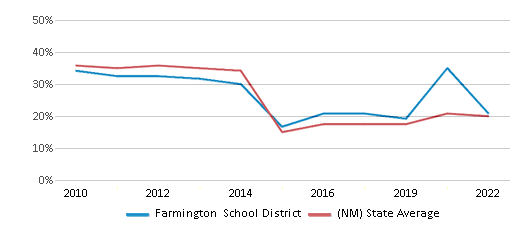
Reading/Language Arts Test Scores (% Proficient)
31%
34%
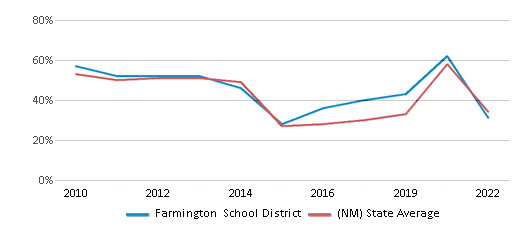
Science Test Scores (% Proficient)
37%
33%
Graduation Rate
(20-21)78%
66%
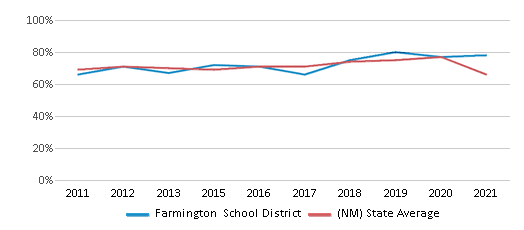
Students by Ethnicity:
Diversity Score
0.71
0.51
# American Indian Students
4,037 Students
9,963 Students
% American Indian Students
36%
10%
# Asian Students
69 Students
1,212 Students
% Asian Students
1%
1%
# Hispanic Students
3,255 Students
66,943 Students
% Hispanic Students
29%
67%
# Black Students
54 Students
1,808 Students
% Black Students
1%
2%
# White Students
2,952 Students
17,642 Students
% White Students
27%
18%
# Hawaiian Students
8 Students
109 Students
% Hawaiian Students
n/a
n/a
# Two or more races Students
719 Students
2,033 Students
% of Two or more races Students
6%
2%
Students by Grade:
# Students in PK Grade:
278
10,488
# Students in K Grade:
638
13,971
# Students in 1st Grade:
720
13,648
# Students in 2nd Grade:
770
13,989
# Students in 3rd Grade:
803
12,987
# Students in 4th Grade:
789
12,815
# Students in 5th Grade:
788
12,895
# Students in 6th Grade:
826
3,498
# Students in 7th Grade:
812
1,017
# Students in 8th Grade:
834
1,002
# Students in 9th Grade:
934
1,137
# Students in 10th Grade:
1,051
926
# Students in 11th Grade:
928
693
# Students in 12th Grade:
923
644
# Ungraded Students:
-
-
District Revenue and Spending
The revenue/student of $11,613 in this school district is less than the state median of $14,756. The school district revenue/student has stayed relatively flat over four school years.
The school district's spending/student of $11,387 is less than the state median of $14,121. The school district spending/student has stayed relatively flat over four school years.
Total Revenue
$129 MM
$4,694 MM
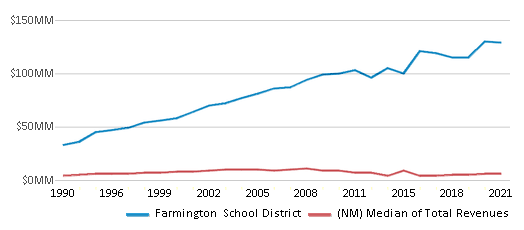
Spending
$126 MM
$4,492 MM

Revenue / Student
$11,613
$14,756
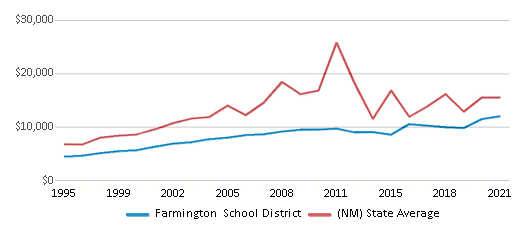
Spending / Student
$11,387
$14,121
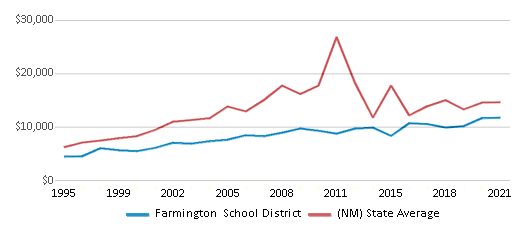
Best Farmington School District ÎÛÎÛÂþ» Preschools (2025)
School
(Math and Reading Proficiency)
(Math and Reading Proficiency)
Location
Grades
Students
Rank: n/an/a
Farmington Preschool Academy East
Special Education School
5840 Fortuna Dr
Farmington, NM 87402
(505) 599-8625
Farmington, NM 87402
(505) 599-8625
Grades: PK
| 98 students
Rank: n/an/a
301 N Court Ave
Farmington, NM 87401
(505) 599-8744
Farmington, NM 87401
(505) 599-8744
Grades: PK
| 180 students
Recent Articles

Year-Round Or Traditional Schedule?
Which is more appropriate for your child? A year-round attendance schedule or traditional schedule? We look at the pros and cons.

Why You Should Encourage Your Child to Join a Sports Team
Participating in team sports has a great many benefits for children, there is no doubt. In this article you will learn what those benefits are.

White Students are Now the Minority in U.S. ÎÛÎÛÂþ» Schools
Increasing birth rates among immigrant families from Asia and Central and South America, combined with lower birth rates among white families, means that for the first time in history, public school students in the United States are majority-minority. This shift in demographics poses difficulties for schools as they work to accommodate children of varying language abilities and socio-economic backgrounds.





